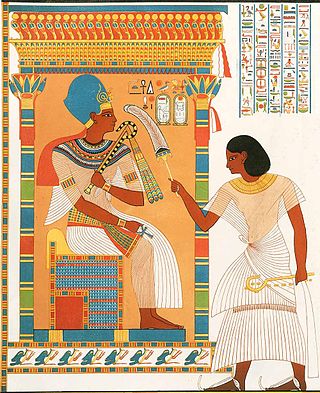Related Research Articles
Thutmose is an anglicization of the ancient Egyptian personal name dhwty-ms, usually translated as "Born of the god Thoth".

Seti II was the fifth pharaoh of the Nineteenth Dynasty of Egypt and reigned from c. 1203 BC to 1197 BC. His throne name, Userkheperure Setepenre, means "Powerful are the manifestations of Re, the chosen one of Re." He was the son of Merneptah and Isetnofret II and occupied the throne during a period known for dynastic intrigue and short reigns, and his rule was no different. Seti II had to deal with many serious plots, most significantly the accession of a rival king named Amenmesse, possibly a half brother, who seized control over Thebes and Nubia in Upper Egypt during his second to fourth regnal years.
The former Kingdom of Kerma in Nubia, was a province of ancient Egypt from the 16th century BCE to 11th century BCE. During this period, the region was ruled by a viceroy who reported directly to the Egyptian Pharaoh.

Piankh was a High Priest of Amun during the 21st Dynasty.

Akhenre Setepenre Siptah or Merneptah Siptah was the penultimate ruler of the Nineteenth Dynasty of Egypt. His father's identity is currently unknown. Both Seti II and Amenmesse have been suggested although the fact that Siptah later changed his royal name or nomen to Merneptah Siptah after his Year 2 suggests rather that his father was Merneptah. If correct, this would make Siptah and Seti II half-brothers since both of them were sons of Merneptah.

Aakheperre Setepenre Osorkon the Elder was the fifth king of the 21st Dynasty of Ancient Egypt and was the first Pharaoh of Meshwesh origin. He is also sometimes known as Osochor, following Manetho's Aegyptiaca.
Hori may refer to:
Ahmose called Turo was Viceroy of Kush under Amenhotep I and Thutmose I.

Merymose, also Mermose or Merimes, was a Viceroy of Kush under Amenhotep III. He served for almost the entire four decades of that reign.

Amenhotep called Huy was Viceroy of Kush under 18th Dynasty King Tutankhamen. He was the successor of Tuthmosis, who served under Akhenaten. He would later be succeeded by Paser I.

Amenemopet served as Viceroy of Kush during the reign of Seti I.
in Ancient Egypt, Paser II was the son of the High Priest of Min and Isis named Minmose. Paser came from a very well-connected family. One uncle was the High Priest of Amun Wennenefer and another uncle was the troop commander of Kush named Pennesuttawy. Through Wennenefer, Paser was related to Amenemone, Amenemope and Hori, the High Priest of Anhur.
Paser I was the Viceroy of Kush during the reigns of Ay and likely Horemheb. Reisner mentions that the only datable inscriptions for Paser belong to the reign of Ay. The next known Viceroy however is Amenemopet, who is dated to the reign of Seti I. Hence it's possible that Paser I served during the reigns of Ay, Horemheb.
Tuthmose was the Viceroy of Kush during the reign of Akhenaten. Tuthmose was given the titles King's Son of Kush, Overseer of the Gold Lands of Amun, Overseer of masons, Overseer of the borderlands of His Majesty, and Fan-bearer on the King's right.

The Viceroy of Kush Seti is attested in year 1 of Siptah. Seti is also mentioned on some monuments of his son Amenemhab. Amenemhab was the son of Seti and the Lady Amenemtaiauw. Seti held the titles fan-bearer on the king's right, and king's scribe of the letters of the Pharaoh. His son Amenemheb served as Head Bowman, Charioteer of His Majesty, and Overseer of the Southern Lands.
Hori II is a son of Hori I and also served as Viceroy of Kush. Their tombs have been found in Tell Basta. Hori II may have been the father of a later Viceroy named Wentawat.

Wentawat, was Viceroy of Kush under Ramesses IX, during the 20th Dynasty. He was a son of the Viceroy Nahihor.
This page list topics related to ancient Egypt.
Iuty was an ancient Egyptian vizier presumably of the Late New Kingdom whose family tomb made up of bricks was discovered in December 1964 by the Egyptian archaeologist Shafik Farid, in the so-called "Cemetery of the Nobles" of Bubastis. The tomb was situated near to the family tombs of Hory I and Hory II, two viceroys of Kush during the 20th Dynasty. Iuty's tomb architecture has remained unpublished, but some objects of the burial equipment including faience and calcite shabtis as well as a calcite model scribe's palette have recently been studied. Iuty cannot be dated precisely at present; but according to the German Egyptologist Jan Moje, he may have officiated during the 20th Dynasty. A calcite canopic jar belonging to Iuty's son, the high-priest of Bastet, Ay, was also found in the same tomb. Before this discovery Iuty was only known from a few objects seen at the beginning of the 20th century on the art market in Cairo.
Hori was a High Priest of Anhur during the reign of Ramesses II. He was the son of the High Priest of Amun Parennefer called Wennefer and his wife Isis. He may be identical to the High priest of Amun mentioned on the statue of the Overseer of the Charioteers named Kanakht.